Centauri Dreams
Imagining and Planning Interstellar Exploration
MU69: New Horizons and its Target
We’re just a little more than a year away from New Horizons’ encounter with Kuiper Belt Object MU69. The spacecraft has now made its last trajectory correction of the cruise phase of its journey, following the 2015 flyby of Pluto/Charon, an adjustment performed to optimize science at destination. Both the Hubble instrument and the European Space Agency’s Gaia mission have supplied data that is now being used to tighten the parameters of the trajectory. Another course correction is possible in October of 2018 during the MU69 approach phase.
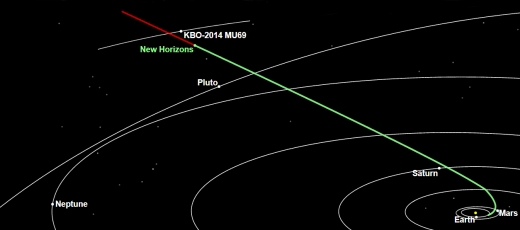
Image: The New Horizons spacecraft is about 483 million kilometers from 2014 MU69, the Kuiper Belt object it will encounter on Jan. 1, 2019. Credit: NASA/Johns Hopkins University Applied Physics Laboratory/Southwest Research Institute.
This update from JHU/APL tells us that closest approach is now scheduled for 0533 UTC, or 0033 EST on January 1, 2019, which should give many New Year’s partygoers something extra to stay up for. The course adjustment was performed to optimize visibility for the antennae of the Deep Space Network, which will reflect radar waves off the surface of MU69 in an experiment that, if successful, will help determine the reflectivity of its surface.
The 2.5-minute engine burn on December 9 thus sets a record for the farthest spacecraft course correction ever performed, at a distance of 6.1 billion kilometers. At this distance, radio confirmation took 5 hours and 41 minutes. The course was adjusted by approximately 151 centimeters per second, setting up a planned flyby distance of 3500 kilometers. New Horizons goes back into hibernation mode on December 21 and will remain in that mode until June.
Learning About the Target
Meanwhile, the occultation events of last June and July, which saw teams setting up telescopes in the shadow of the KBO as it passed in front of a star, have proved invaluable at assessing the shape of MU69, particularly the July 17 occultation, which produced information on the object’s size, shape and orbital characteristics. But it was data gathered by the Stratospheric Observatory for Infrared Astronomy (SOFIA) on July 10 that may be the most provocative, showing an abnormality in the occultation that could indicate a small moon.
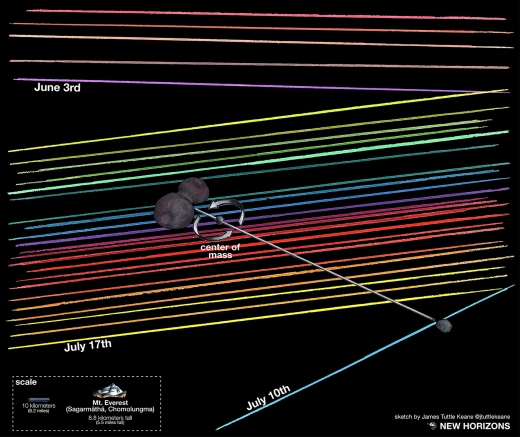
Image: On three occasions in June and July 2017, New Horizons mission team members attempted to track a small, distant Kuiper Belt object, 2014 MU69, as it passed in front of a star – an event known as an occultation. The colored lines mark the path of the star as seen from different telescopes on each day; the blank spaces on those lines indicate the few seconds when MU69 blocked the light from the star. Scientists are using these observations to craft a picture of MU69 and any companion bodies. (Credit: NASA/Johns Hopkins University Applied Physics Laboratory/Southwest Research Institute/James Tuttle Keane).
Marc Buie (SwRI), a member of the New Horizons science team, updated the analysis of the MU69 occultations at the American Geophysical Union fall meeting in New Orleans.
“We really won’t know what MU69 looks like until we fly past it, or even gain a full understanding of it until after the encounter,” said Buie. “But even from afar, the more we examine it, the more interesting and amazing this little world becomes… A binary with a smaller moon might also help explain the shifts we see in the position of MU69 during these various occultations. It’s all very suggestive, but another step in our work to get a clear picture of MU69 before New Horizons flies by, just over a year from now.”
What we do know at this point is that MU69 is more than 6.5 billion kilometers from Earth and no more than 30 kilometers long if a single object, or if it is a binary, then each component is roughly 15-20 kilometers in diameter. Scientists are hopeful that the flyby will give us information about the earliest era of planet formation in the outer Solar System. In any case, the more we learn about it, the more intriguing this clearly worthwhile target becomes.
“The occultation effort that Marc Buie and his team led for New Horizons has been invaluable in opening our eyes to the very real possibilities that MU69 is both a lot more complex than anyone suspected, and that it holds many surprises for us at flyby on New Year’s Eve and New Year’s Day, 2019,” added New Horizons principal investigator Alan Stern, also from Southwest Research Institute. “The allure of its exploration is becoming stronger and stronger as we learn more and more about it. It’s just fantastic!”
As the mission continues, you can keep up with New Horizons’ position here.

Keeping Up with Juno
We’re getting interesting results from analysis of Juno’s close flybys of Jupiter. The spacecraft has detected hydrogen, oxygen and sulfur ions moving at relativistic speeds in a new radiation zone just outside the atmosphere. We have its JEDI (Jupiter Energetic Particle Detector Instrument) to thank for the detection, which was made during approaches as close as 3400 kilometers from the cloud tops. Fast moving atoms without an electric charge — energetic neutral atoms — are thought to be the source of the new radiation zone as they move from gas around Io and Europa and become ionized in Jupiter’s upper atmosphere.
The new radiation zone is inside Jupiter’s previously known radiation belts, which have also been under scrutiny by Juno. High-energy, heavy ions have been detected in the inner edges of the planet’s electron radiation belt, previously thought to be made up primarily of electrons moving at near light speed. The heavy ions show up at high latitude locations within the electron belt, detected by Juno’s Stellar Reference Unit (SRU-1) star camera. You can see the locations where they were detected in the bright spots along the white line of Juno’s flight path below.
“The closer you get to Jupiter, the weirder it gets,” said Heidi Becker, Juno’s radiation monitoring investigation lead at JPL. “We knew the radiation would probably surprise us, but we didn’t think we’d find a new radiation zone that close to the planet. We only found it because Juno’s unique orbit around Jupiter allows it to get really close to the cloud tops during science collection flybys, and we literally flew through it.”
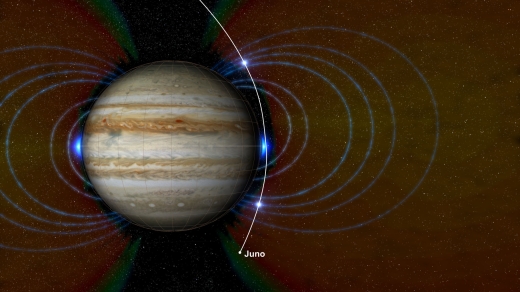
Image: This graphic shows a new radiation zone surrounding Jupiter, located just above the atmosphere near the equator, that has been discovered by NASA’s Juno mission. The new radiation zone is depicted here as a glowing blue area around the planet’s middle. Credit: NASA/JPL-Caltech/SwRI/JHUAPL.
Meanwhile, Juno’s microwave radiometer (MWR) instrument also culled data during Juno’s passage over the Great Red Spot in July of 2017. The figure below represents six channels of these data. Using the MWR, Juno can see deeper than any previous ground- or space-based observations into the clouds. It’s interesting to note that the large-scale structure of the Great Red Spot is evident as deep into the planet as the MWR can observe. 16,000 kilometers wide, the Great Red Spot is a vast crimson storm that has been monitored since 1830. It was twice Earth’s diameter when the Voyagers studied it but has since diminished in width.
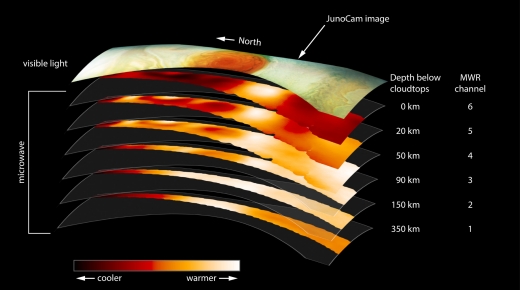
Image: This figure shows data from the six channels of the microwave radiometer (MWR) instrument onboard NASA’s Juno spacecraft. The data were collected in the mission’s sixth science orbit (referred to as “perijove 7”), during which the spacecraft passed over Jupiter’s Great Red Spot. The top layer in the figure is a visible light image from the mission’s JunoCam instrument, provided for context. Credit: NASA/JPL-Caltech/SwRI.
“Juno found that the Great Red Spot’s roots go 50 to 100 times deeper than Earth’s oceans and are warmer at the base than they are at the top,” said Andy Ingersoll, professor of planetary science at Caltech and a Juno co-investigator. “Winds are associated with differences in temperature, and the warmth of the spot’s base explains the ferocious winds we see at the top of the atmosphere.”
But below is the image that awakens the science fiction fan in me. It’s an animation assembled from JunoCam imagery to give us a sense of the winds in the Great Red Spot, using a velocity field model derived from earlier observations including those from Voyager. The animation is the work of two citizen scientists, Gerald Eichstädt and Justin Cowart, with Juno scientists Shawn Ewald and Andrew Ingersoll applying the velocity data to produce the finished animation.
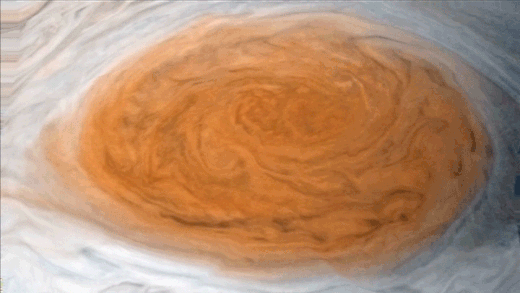
Image: Winds around Jupiter’s Great Red Spot are simulated in this JunoCam view that has been animated using a model of the winds there. The wind model, called a velocity field, was derived from data collected by NASA’s Voyager spacecraft and Earth-based telescopes. NASA’s Juno spacecraft acquired the original, static view during passage over the spot on July 10, 2017. Credit: NASA/JPL-Caltech/SwRI/MSSS/Gerald Eichstadt/Justin Cowart.
If you’d like to dig into the analysis of radiation data, the paper is Kollman et al., “A heavy ion and proton radiation belt inside of Jupiter’s rings,” Geophys. Res. Lett 44, 5259-5268 (abstract).

METI: A Longer-Term Perspective
While the debate over sending messages to nearby stars continues, it’s interesting to probe the issue quantitatively, as Jim Benford did on Friday, asking whether recent attempts at METI could be heard at destination. The subject prompts Keith Cooper, now editor at Astrobiology Magazine, to examine ways of reaching consensus on a matter that raises strong opinions whenever it is raised. If these messages are unlikely to be heard, is there a technological window here that we can use to find consensus through continuing research? Keith is well-known to Centauri Dreams readers, having engaged with me in a series of dialogues over the years on various interstellar topics. Look for a new dialogue early in 2018.
By Keith Cooper
On Friday, Jim Benford’s brilliant essay showed how the latest METI signal will not even be heard at its target destination, the planet GJ 273b, which is only 12.4 light years away. Whichever side of the debate you fall on, messages that can’t be detected at their target are a waste of resources. In light of this, METI activists may want to rethink their strategy.
(As an aside, this highlights why civilisations might be hesitant about transmitting without knowing that there is going to be someone listening; the resources, both in terms of energy and time, that are required to do the job properly are huge and you can imagine that frugal civilisations might not bother, or only do so sporadically.)
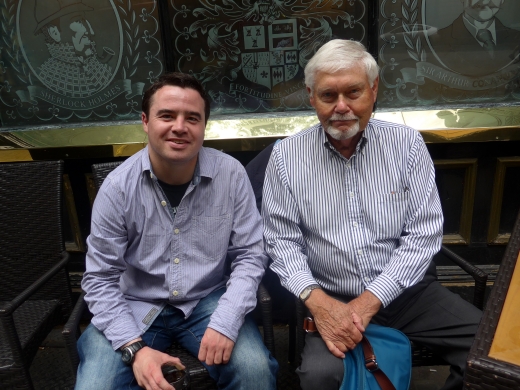
Image: Keith Cooper (left) with Jim Benford at a recent meeting in London.
There’s a window of opportunity here for both sides of the argument to come together while METI is effectively curtailed by a lack of access to sufficiently powerful transmitters (which, besides Arecibo and military radar, are thin on the ground). I’m not thinking of spending this time endlessly debating the issues. The SETI Institute’s Seth Shostak has suggested that the conclusion of any symposia called to discuss the risks of METI will always be a foregone one against transmitting (which may explain why METI activists are so keen to avoid discussion), because since we have no understanding of how ET will behave, there will always be a risk.
I think he’s probably right, but then I have to ask myself, is that the kind of civilisation that I want us to be, forever shackled by fear? I look at some of the names involved in METI International and I am honestly surprised. So many of those listed on their website are smart people whom I admire greatly, people such as Jerome Berkow, Steven Dick, Alan Penny, Paul Davies, George Dvorsky, Chris Impey, James Kasting, Lori Marino and on and on. If so many smart people whose opinion I respect are in favour of deliberately seeking contact, who am I, a mere journalist, to disagree?
You know something? I don’t disagree. Neither, I’m willing to bet, do Jim Benford, David Brin or any of the other vocal critics of METI. We don’t want to hide from contact – ultimately that’s the whole point of doing SETI. The difference comes in that we don’t think sending out signals left, right and centre, with no thought put into who we are trying to contact and what we’re trying to say, is the responsible way to announce ourselves on the galactic stage.
Scouting the Galaxy
I think there’s an alternative way. I will warn you now, it will require patience, but if we are to get to the end of this century in at least as good a shape as when we entered it, then we will need to be patient and implement long-term plans to combat climate change, over-population, poverty and so on. Why should our attempts to make contact, given the vast distances and timescales involved, be an exception?
Our current situation is that we don’t know what is out there. So before transmitting, let’s perform some reconnaissance. The advent of the Breakthrough Starshot project, which intends to fire laser beams to accelerate thousands of tiny ‘StarChip’ nano-probes to a fifth of the speed of light towards Alpha Centauri, makes such reconnaissance eminently more probable. If all goes well, the first StarChips could be launched by the middle of this century. In just over 20 years they would reach their destination, but why stop at sending these probes to Alpha Centauri? Travelling at 0.2c, they could reach GJ 273b within 62 years. The probes could survey the system for signs of life or even technology (perhaps in the form of city lights, atmospheric pollution or artificial structures), and report back.
In the intervening years our largest telescopes will be able to perform their own kind of reconnaissance from a distance. The James Webb Space Telescope, the European Extremely Large Telescope and the Thirty Meter Telescope will all be able to perform spectroscopic analysis of the atmospheres of the nearest potentially habitable worlds, searching for biosignatures including gases that are in chemical disequilibrium with their environment, such as oxygen, methane and others. The latter two ground-based telescopes might even be able to directly image these planets. The Square Kilometre Array and the FAST telescope in China will listen intently for SETI signals. We will learn more about our own Solar System, about how the conditions to support life came about on Earth, and whether life exists elsewhere in our Solar System, be it on Mars, Europa or Enceladus. We will come to a much better understanding of life in the Universe and the odds on finding such life elsewhere.
The point is, over the next century we will be in a far better position to say whether there is life out there in any nearby planetary systems. In fact, I’ll go one step further and make a bet that, if life exists on a planet anywhere within 50 light years of here, we will have found it by 2100. Our probes will be sent to investigate surreptitiously, likely too small to be detected by any civilisation out there. Once we’ve learned of them, and about them, we will be in a far better position to deliberately open a channel of communication with them, with first contact performed by trained diplomats and scientists. This would be in stark contrast to secretly sending out a message and not making that information public for a month. A group that claims to speak for Earth but which does so in secret isn’t speaking for anybody but themselves.
Patience in good measure
As I write this, I’m reminded of Milan ?irkovi?’s hypothesis of energy-optimised ‘city states’ in his ‘Against the Empire’ paper, wherein civilisations recognise the huge expense of transmitting signals or launching crewed interstellar spaceflight, and instead send out scouts in the form of robotic probes to explore the Galaxy and seek out life. Indeed, interstellar probes have long been part of the fabric of SETI, going back to Ronald Bracewell in the 1960s and the novels of Fred Saberhagen (although his berserkers aren’t quite what I have in mind!).
If, after launching our probes and scrutinising nearby planets with our telescopes, we find intelligent life, and we get an idea of what they’re about, then we can consider opening hailing frequencies with them. This approach lacks the immediate satisfaction of sending messages now, and quite possibly none of us will be alive when we find such life, but in the long-term – and make no mistake, contact with another civilisation will have repercussions, good or bad, that run into the long term – it seems the most sensible way to go about making contact.
It does require patience and perseverance to see the plan through to its end, but METI activists often deny that they are being impatient when they rush to beam their messages out into space. Seeing as their messages are not currently powerful enough to be heard by anyone anyway, this is their chance to prove that they are not acting out of impatience by joining a century-long plan to make contact by initially performing the required reconnaissance of our neighbourhood, taking the time to learn a little more about what’s out there. While we are performing our reconnaissance, we will be able to take the time to really figure out how we want to communicate in a responsible fashion and prepare society for the potential of contact.
The SETI 2020 report called for cultural maturity before we make any big decisions about contact. By finding the patience to maintain a century-long project of exploration of nearby planetary systems, maybe we can reach the required level of maturity.
So I’m throwing down the gauntlet. To those whose aim is to find life in the Universe, I say, come together and develop a long-term plan towards achieving this aim. To the METI activists, I say, hold off on your wasteful transmissions and join us. It may take a while; we may not be alive to see its completion, but once our project has found intelligent life, once we’ve performed surveillance to understand that life better and the associated risks of contact, then let’s transmit together, as a united world. The risks will be far less and the potential benefits or working together far, far greater.

Whispering At The Stars
Recent activity in sending signals to the stars has caught the attention of plasma physicist Jim Benford. The CEO of Microwave Sciences and chairman of the Sail Subcommittee for Breakthrough Starshot, Jim has more than a few doubts about the efficacy of these signals, and questions the rush to send them. Is the recent EISCAT signal detectable at interstellar distances? A look at the science of such signals follows, and thoughts on the caution with which we ought to proceed.
By James Benford

Yet another ‘Message’
Recently, advocates of METI (Messaging to Extraterrestrials) sent a ‘message’ consisting of prime numbers followed by 36 music pieces to Luyten’s Star. It was a collaboration of METI International, led by Doug Vakoch, with the Catalonia Institute of Space Studies. This star is 12.4 light years from Earth and has a potentially habitable exoplanet (GJ 273b).
This was sent from the EISCAT facilities near Tromsø, Norway, using a microwave antenna. The music pieces are 10 seconds long, therefore contain only 1500 bits, so are quite simple.
Can this deliberate transmission from Earth be detected at the distances of nearby stars? What is the reality of claims that the low power messages sent to date are ‘practically detectable’? Such qualitative statements are not useful in a quantitative science. We will see that the message is faint and very unlikely to be detected, even if aimed at nearer stars.
How detectable will the message actually be?
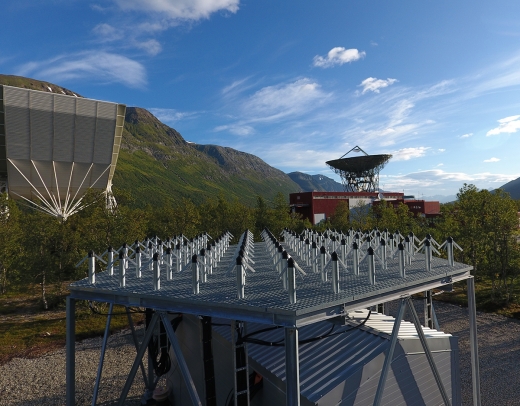
Image: EISCAT Tromsø site with the EISCAT3D test facility in the foreground. Credit: Craig Heinselman.
Can it be heard?
No. This group is in fact whispering at the stars.
I base this on what we know about Vakoch’s transmission: power 2MW, 32 meter dish, frequency 929-930.2MHz, bit rate 125 bits/s, encoded to 8 bits PCM and to a frequency of 6.4 kHz, repeating the 33 minute signal three times over three days.
Analysis of this EISCAT (European Incoherent Scatter Scientific Association) METI, accounting for differences in power, aperture and frequency, is that the power density at long range (EIRP, effective isotropic radiated power) is only 1/100th of Arecibo, and a 10th of that used by Alexander Zaitsev in his messages. Therefore, the several observations and conclusions that John Billingham and I made 3 years ago about the unobservable Zaitsev ‘messages’ are true in spades for this failed transmission as well (“Costs and Difficulties of large-scale METI, and the Need for International Debate on Potential Risks”, John Billingham and James Benford, JBIS 67, pg. 17, 2014).
The conclusion is: This will not be detectable as a message by radio telescopes such as we have on Earth. The energy might be detected with radio telescopes larger than any we have, integrating the signal, but there isn’t much integration time, and integration would destroy the content of Vakoch’s transmission. So it will not be recoverable as a message by ETI if their radio telescopes are comparable to or substantially greater than ours. (One can of course assume a Supercivilization only 12 light years away with vastly larger radio telescopes. But if our leakage were detectable by them, as the METI-ists claim, then their greater leakage radiation would surely be detectable by us. But we do not see it.)
Dave Messerschmitt, who is in METI International’s Advisory Council, but wasn’t consulted about this message, observes:
“This METI signal is a simple on-off keying scheme, which dates to the 1837 invention of the telegraph. It has the virtue of extreme simplicity and transparency. However, there are modulation and coding techniques known today that operate near the fundamental limits of data-rate vs energy, such as is described in my paper “Design for Minimum Energy for Interstellar Communications.
“For the same average power (and energy consumption) such signal designs can considerably increase the distance over which information can be reliably extracted. They have other benefits, such as easier discovery and less susceptibility to local sources of radio-frequency interference. However energy-efficient signals will be essentially unobservable by long-term spectrum analysis. Rather, transient (short-term energy) analysis is more effective for such signals. They also require a transmitter implementation capable of high peak-to-average power ratios.”
Note also that the following must all occur for ETI to detect this weak signal:
1) Their system must stare in the very small part of the sky where our sun is, i.e., they must be interested in our system. (To get high sensitivity, the antenna area must be large, so the targeting angle is very small.) This could be because they’ve detected our out-of-equilibrium atmosphere, thus possible life here. This has been true for billions of years.
Or they could have detected our leakage radiation. But the bandwidth of incoherent leakage sources, such as TV and radar, is too wide and the power too unfocused for such signals to escape the Solar System, let alone reach other stars, before it’s indistinguishable from noise.
2) They would have to guess the bit rate of the message. Processing the stored signal with successive assumed rates and seeing which gives the best signal could do this.
3) They would have to deduce that we’re using simple on-off keying instead of another of our many modulation methods, so must analyze the received signal against a list of such stratagems.
While all the above could occur, this is by no means certain.
A decent respect for the opinion of mankind…
They are Star Whisperers. They show no decent respect for the opinion of mankind, to quote a certain historical document, in speaking for Earth.
What we see here is yet another attempt by the METI-ists to announce ourselves to the stars with weak signals that have no serious possibility of being received and interpreted. After several such transmissions in the last decade, they continue to make false claims and send silly signals, paying no attention to the scientific fact that their messages cannot be heard. And they continue to advertise such matters as the following:
“I would say, on behalf of the Klingons, that I prefer to listen to some good music than to the empty whistle of SFO’s radar.” – Seth Shostak
Seth Shostak surely knows that the San Francisco Airport short-range radar, being weak in power with a very low gain antenna, cannot be heard beyond the moon. He certainly knows this if he does any quantitative calculation. They claim, quite falsely, that we have announced ourselves by leakage radiation or intentional transmissions in recent years. This is not true. Therefore these are simply claims to excite the public. This is not an intellectually defensible position.
I advise the METI-ists to restrain themselves from trying to signal ETI. They are not being given access to seriously high power facilities such as Arecibo because they have no rationale for sending messages. They have no claim to speak for Earth.
In 2014 John Billingham and I made several suggestions in our paper referenced above. The time has come to address the METI issue on an international scale by establishing international symposia on transmitting from Earth to ETI. I advocate a moratorium on METI until an international consensus has been reached about announcing ourselves to the stars.

A Second Super-Earth for K2-18
The transiting red dwarf K2-18 is about 111 light years out in the general direction of the constellation Leo, with a mass of 40 percent of Sol’s. A super-Earth, K2-18b, was detected here in 2015 through light curve analysis of data from the reconfigured Kepler K2 mission, and we now have the first measurement of the planet’s mass, drawing on radial velocity data from HARPS. The two planet detection methods in conjunction thus firm up our knowledge of a possible habitable zone planet.
But they also reveal, in the analysis of Ryan Cloutier (University of Toronto) and colleagues, a second super-Earth, K2-18c, which turns out to be non-transiting, and therefore non-coplanar with K2-18b. As we saw yesterday, HARPS (High Accuracy Radial Velocity Planet Searcher), is capable of drilling down to about one meter per second in the analysis of the stellar wobbles that radial velocity methods examine. The current data set gives us another interesting world while reminding us of the capabilities of the ESPRESSO spectrograph I talked about yesterday.
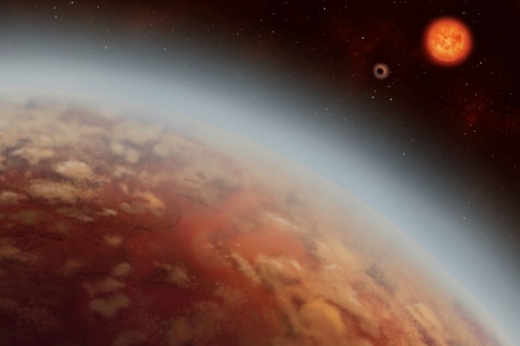
Image: An artist’s conception of planet K2-18b, its star K2-18 and the second planet K2-18c. Credit: Alex Boersma (www.alexboersma.com). Two things I like about this image: Its evocative feel, an imaginative take on a world whose actual conditions are speculative, and the fact that the artist is given credit by the Université de Montréal Institute for research on exoplanets (iREx). Artists should always get credit but all too often do not in press materials.
When it came to K2-18b, the challenge was to figure out whether the planet was a gaseous mini-Neptune or a predominately rocky world. Hence the importance of the radial velocity measurements, giving us in combination with earlier transit data a tentative mass as well as a radius, allowing the planet’s density to be inferred. The researchers believe K2-18b is either a large, rocky planet with a small gaseous atmosphere or a water planet with an ice crust. The range is explained by the uncertainty in the measured mass, which the paper cites at 24%.
It’s interesting to note that this planet’s mass is close to that of another possible habitable zone planet, LHS 1140b, though the dissimilarities are also striking:
K2-18b is of a similar mass to the habitable zone planet LHS 1140b (Dittmann et al. 2017) and receives a comparable level of insolation despite being ? 1.6 times larger than LHS 1140b. Analyzing the mass-radius relationship of these small planets over a range of equilibrium temperatures is a critical step towards understanding which of these systems have retained significant atmospheric content thus making them more suitable to extraterrestrial life.
Given the inability to distinguish between the two outcomes, we have to look to future instruments, like the upcoming James Webb Space Telescope. Cloutier points out that JWST should be able to probe the atmosphere of K2-18b to make the call. We keep bumping up against this ceiling as we wait for new instruments to come online. A nearby transiting world, this planet should climb toward the top of the target list for atmospheric analysis. K2-18 is now the second brightest M dwarf with a transiting habitable zone planet behind LHS 1140.
On JWST, by the way, be sure to read the always reliable Lee Billings’ article What Will NASA’s Biggest-Ever Space Telescope Study First? for a look at the inevitable prioritization of observing time and also the potential of the space telescope. A quick bit from the essay:
Unlike Kepler, which simply surveyed a single star-packed field of view for transits, Webb can zoom in on individual transiting worlds for deeper study. Astronomers should be able to use it to detect water vapor, methane, carbon dioxide and other gases in some silhouetted planets’ upper atmospheres by monitoring the starlight streaming through. They could also record a planet’s passage in front of and then behind its star, using the difference between the two observations to crudely measure a world’s temperature, weather patterns and clouds. “Webb is going to be great for exoplanets,” says Kepler project scientist Natalie Batalha, an astronomer at NASA Ames Research Center who leads the most time-intensive ERS program, which will use nearly 80 hours of Webb’s time to study transiting worlds. “It’s just that this is a difficult game to play, because the signals we’re looking for are really tiny. Seen [in transit] from another star, Venus blocks one part per ten-thousandth of the sun’s light, and its atmosphere intercepts one two-hundredth of that. It’s tough to see—you need a big mirror and great instrumentation to do it.”
As to newly detected K2-18c, the researchers looked for but did not find significant transit timing variations (TTV) in the K2 data. The Cloutier paper continues:
The orbit of the newly discovered K2-18c lies interior to that of K2-18b and yet the planet is non-transiting. This implies that the orbital planes of the planets are mutually inclined. In order for K2-18c to not be seen in-transit the planetary system requires a mutual inclination of just ? 1.4° which is consistent with the observed distribution of mutually inclined multi-planet systems (Figueira et al. 2012; Fabrycky et al. 2014).
The team’s dynamical simulations show that the oscillation timescale of the planets’ orbital inclinations is in the range of 106 years, meaning that it may be a long time before K2-18c can be seen in a transit from Earth. And the authors believe that finding the second planet through radial velocity data emphasizes the prevalence of Earth- to super-Earth size planets in M-dwarf systems, with multi-planet systems offering potential insights into planet formation processes around M-dwarfs. Comparative planetology here we come.
The paper is Cloutier et al., “Characterization of the K2-18 multi-planetary system with HARPS: A habitable zone super-Earth and discovery of a second, warm super-Earth on a non-coplanar orbit,” submitted to Astronomy & Astrophysics (preprint).

First Light for ESPRESSO
What great news that ESPRESSO, the Echelle SPectrograph for Rocky Exoplanet and Stable Spectroscopic Observations, has just achieved ‘first light.’ The spectrograph is installed on the European Southern Observatory’s Very Large Telescope at the Paranal Observatory in northern Chile and its powers are prodigious. For ESPRESSO makes it possible, for the first time, to combine the light of all four telescopes at the VLT. This creates an instrument with the light collecting power of a 16-meter telescope, a major enhancement to the exoplanet hunt.
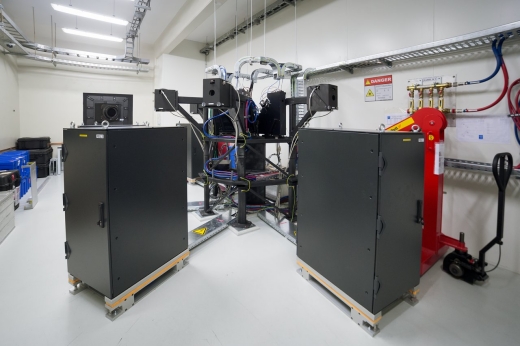
Image: The room where the light beams coming from the four VLT Unit Telescopes are brought together and fed into fibres, which in turn deliver the light to the spectrograph itself in another room. One of the points where the light enters the room appears at the back of this picture. Credit: ESO/P. Horálek.
Thus the enthusiasm of lead scientist Francesco Pepe (University of Geneva):
ESPRESSO isn’t just the evolution of our previous instruments like HARPS, but it will be transformational, with its higher resolution and higher precision. And unlike earlier instruments it can exploit the VLT’s full collecting power — it can be used with all four of the VLT Unit Telescopes at the same time to simulate a 16-metre telescope. ESPRESSO will be unsurpassed for at least a decade — now I am just impatient to find our first rocky planet!”

Image: This colorful image shows spectral data from the First Light of the ESPRESSO instrument on ESO’s Very Large Telescope in Chile. The light from a star has been dispersed into its component colours. This view has been colourised to indicate how the wavelengths change across the image, but these are not exactly the colours that would be seen visually. Close inspection shows many dark spectral lines in the stellar spectra and also the regular double spots from a calibration light source. The dark gaps are features of how the data is taken, and are not real. Credit: ESO/ESPRESSO team.
We’re going to be hearing a lot from ESPRESSO because it will greatly improve our powers of radial velocity observation. Remember what we are doing when we use these techniques. Radial velocity involves extracting the tiny Doppler signature of star motion as the star is pulled first one way, then another, by the planets around it. Compared to the size of the star, the movements are small but we can trace them in the star’s light spectrum.
Repeating changes to the spectrum as it shifts toward red, toward blue, back toward red, give us the data we need to identify a planet, and until the Kepler mission came along, radial velocity was the primary means we used to find such worlds. 51 Pegasi’s planet, the first found to orbit a main-sequence star, was found using radial velocity methods in 1995. Now we use a mixture of methods including transit studies, direct imaging and gravitational microlensing.
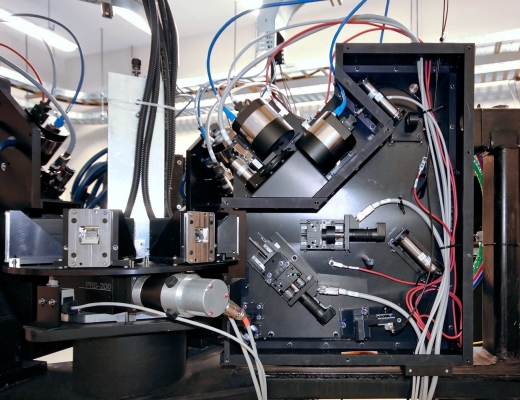
Image: The Echelle SPectrograph for Rocky Exoplanet and Stable Spectroscopic Observations (ESPRESSO) successfully made its first observations in November 2017. Installed on ESO’s Very Large Telescope (VLT) in Chile, ESPRESSO will search for exoplanets with unprecedented precision by looking at the minuscule changes in the properties of light coming from their host stars. This view shows the inside of one of the ESPRESSO front-ends where all the active components of the spectrograph are located. Credit: Giorgio Calderone, INAF Trieste.
Combining methods can be hugely useful, for while radial velocity lets us measure the mass and orbit of the planet (I won’t, for the purposes of this post, get into the problem that RV mass measurements can produce only minimum mass estimates), transits can help us deduce its density. But for those planets that do not transit, we’d like to move further and further down the scale, making detections of ever smaller worlds, terrestrial-class planets perhaps like our own.
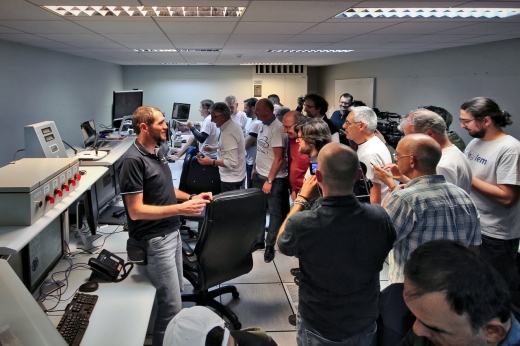
Image: the moment of first light, with the team jubilant in the VLT control room. Credit: Giorgio Calderone, INAF Trieste.
From an ESO fact sheet on ESPRESSO:
The radial velocity technique has been so far the most productive in terms of extra-solar planet detections. Low mass planets (one to few Earth masses) are especially interesting because according to formation models they could represent the bulk of the planet population. However they are more elusive and require extremely stable instruments. The HARPS instrument, with a precision better than 1m/s, has discovered up to now the vast majority of planets with masses smaller than Neptune, giving an invaluable experience in view of the realization of more precise instruments. With a radial velocity precision better than 10cm/s, an Earth mass planet in the habitable zone of a low mass star can be detected.
Exactly so. ESPRESSO picks up where HARPS left off. While HARPS could achieve a precision of one meter per second, ESPRESSO gets us down below 10 centimeters per second. The upscaling is the result of ESPRESSO’s placement to tap the four VLT telescopes as well as advances in spectroscopic technology. The benefit will be in characterizing much less massive planets unavailable for our scrutiny through transits or direct imaging, further bulking up the exoplanet catalog and deepening our statistical analysis of planets near us in the galaxy.


